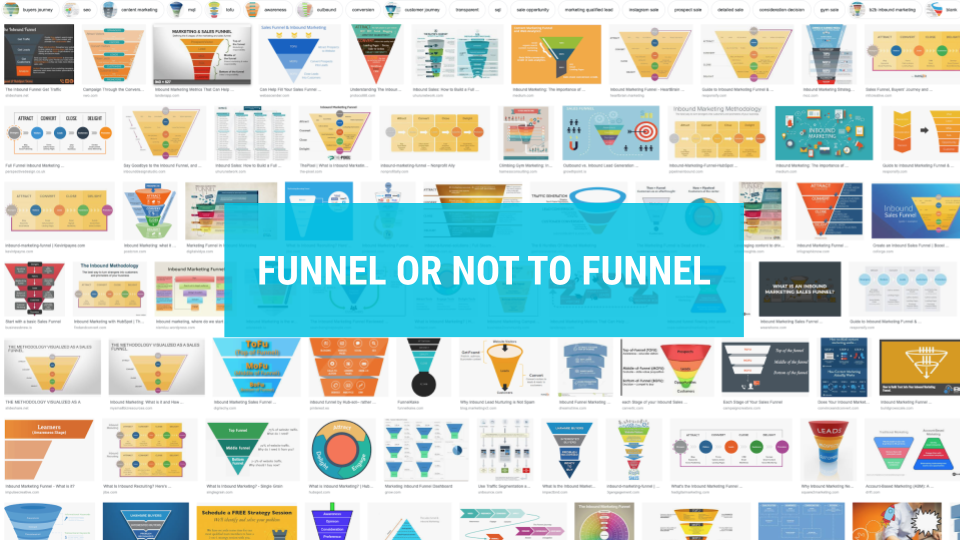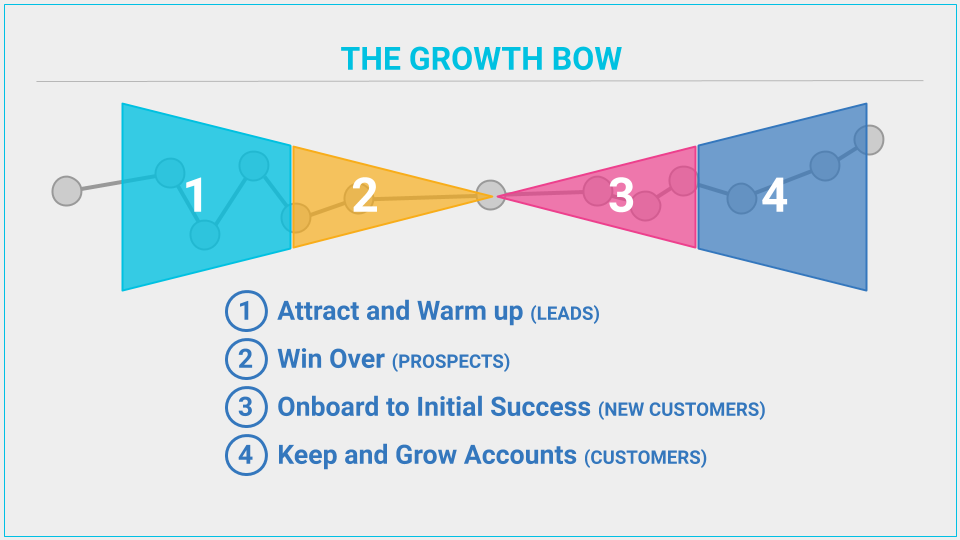B2B Marketing is not just about generating lead, nor is it something you need a marketer for.
In this article, you’ll find where marketing can help sales and why it is often better not to leave it for marketing professionals.
Your Marketing is not a Funnel
You have probably seen your fair share of marketing funnels like below (or google “B2B marketing funnel” and switch to image search).

B2B sales funnel is not much different.
In it's simplest form, it can be divided into 3 segments:
- Top of Funnel (TOFU)
- Middle of Funnel (MOFU) and
- Bottom of Funnel (BOFU) activities.
Top of funnel to attract prospects, middle of funnel to educate them and bottom of funnel to make you trustworthy, to put it simply. The marketing funnel is mostly about generating leads.
This is ok, if you focus heavily on new customer acquisition. In that scenario, your marketing (and sales) won't be that far from the funnel model.
But focusing too much on new customer acquisition is usually bad business.
However for most B2Bs the money really comes from repeat sales to existing customers, not from acquiring disposable customers (which is often bad business).
New customer acquisition tends to be hard and expensive, while additional sales to existing is much easier and lot more profitable.
New customers are often unprofitable first, and probably even for some time: They are expensive to acquire, and require more service up front than existing customers, yet their initial purchases are often well below your averages thus turning many new customers on red. Profit will often come only if the new customers keeps on buying for more. These additional sales are lot easier to get. And with additional purchases they tend to buy more expensive, higher margin products and services, and require less service meaning more profits.
For most B2Bs, big part of marketing is about keeping customers and developing new sales opportunities from them.
The Growth Bow
Thus I prefer to visualize marketing along the customers’ journey with a bow like shape that I call the Growth Bow.
On the left side, you'll find potential customers coming towards the initial sale at different stages, and on the right side, you'll find customers developing towards higher and higher value.

The goal of your sales and marketing is to attract new prospects and turn them into loyal customers. That is, to cover and optimise the whole customer journey, from the first touch to your brand (=company) to the end of the relationship and beyond (to include ex-customers as well).
From your perspective, this journey can be divided into four main areas:
- Lead generation for sales,
- Prospect nurturing during the sales process,
- Onboarding new customers, and
- Keeping and growing accounts.
Succeeding to grow fast is not about acquiring more leads and customers quickly, it's about being the quickest and most (resource) efficient to acquire leads and turn them into loyal high (customer lifetime) value customers.
Customer acquisition is always very expensive and is really financed from the future profits from the customers, so the more profit you'll make, the quickest and with least costs, the more you can invest into either being even more efficient, or acquiring even more leads.
#1. Lead Generation: Attract and Warm Up Leads
Let’s start with the obvious, that is lead generation.
To sell more, sales needs more, and better leads. Leads that have a need. Leads that know who we are, and trust us.
And especially leads that are just the right kind of customers for you.
If, on the other hand, a business does not have enough good quality leads to satisfy it’s growth ambitions, sales have to work from lower quality prospects who needs much more work to win a deal, have limited growth potential, are poor payers, have difficult needs, needs more support... All in all, if you have to work with low volume and quality of leads, it is not just sales that will suffer, but eventually the future of the whole business.
On the other hand, if the business generates plenty of leads, sales can keep bar high and focus on those who are just the right fit, have a recognized need, have a budget, timeline and sponsor for the project…
And better still, if those leads are already made familiar with the business so that they trust and see the business and key employees as true experts in the field, selling is obviously so much more efficient.
But although lead generation is important, it is just one part of the new customer acquisition which in itself is just one part of sales and growth.
Until recently, marketing was often seen as mainly as lead generation activity, and in many B2Bs, it’s success is still measured by the number of leads generated.
However for a healthy growing company, there is so much more how marketing can help sales and business.
In fact, lead generation is probably the most difficult to succeed.
So if you are considering where to start, I usually recommend to consider the following three before lead generation.
Don't leave prospecting for sales
In so many B2Bs, lead generation is left on sales, meaning lots of cold calls or cold emails to find those few interested. Mostly because this used to work. And it used to be the only real option.
However during the digital era, a lot has changed, not alone customer behaviour.
Cold outreach is now so much more difficult than it used to be. But how difficult it really is?
It is often said that it takes over 20 call attempts to get a discussion with a C-level executive.
How many discussions you’ll need to have before finding a prospect who is actually interested? Let's say one out of four is interested and agrees to meet the salesperson.
That means a salesperson needs to make 80 call attempts to have four discussion to generate one lead.
But the customer does not know or trust your company yet. The salesperson starts her salesprocess with low odds to succeed and lots of manual convincing ahead.
With proper marketing, a lead knows and trusts your company before the first contact with your salesperson. And your sales knows who are the most interested and likely to buy, allowing them to start from the best, already warmed up leads with shorter sales cycles.
#2: Prospect nurturing: Helping sales to win more.
The next step is to convert leads into customers.
Now it does not matter whether leads were generated by marketing or by sales by e.g. with cold calling, the real selling starts when a lead is qualified. Traditionally after this point, the client is in the capable hands of sales. Unfortunately very few end up buying.
Only just 3% of those who were interested, are typically ready to buy.
This does not mean they are ready to buy from you though. You still need to win them over. But they have developed their need to the point where they are ready to buy from a vendor.
The rest, 97% are interested but not ready to buy yet.
Maybe they haven’t really recognised the need yet.
Or learn enough to be confident that the problem is worth solving?
Or they might still have other more pressing things on their agenda.
Or... The road from interested to ready to buy can be long and full of obstacles.
No wonder few salespeople can and are willing to do the work. Quite often they ran out of reasons to follow up.
There are only so many times you can call and ask if there is any progress on the customer’s side.
It is quite typical, that sales can ultimately win about 10% of the prospects who showed initial interest.
What happen to those 90-97% who were originally interested?
Some lose interest, end up buying elsewhere or cannot afford to buy eventually, but a considerable portion of those 90-97% interested are not just ready to buy yet.
Either they need more time and information to develop their need or they need more touches with you, your company and your products to trust and prefer you over other vendors, or both.
And this is where marketing can really make a difference, especially with quality content. Blog posts, PDFs, ebooks, webinars, events... help customers to develop their needs further, educate them and build trust towards you as their trusted guide on that journey.
Content marketing will also enable another big advantage: lead tracking. When a lead comes to read a blog post, download an ebook or registers a webinar, the lead can be tracked and thus sales knows how their prospects are consuming your content. This sales intelligence gives clear advantage to sales who can now base their followup activities and approaches on what their leads have actually done (or not done) rather than pointless scheduled followups that takes time and provide little value for either party.
#3: Onboarding to initial success: Turn new customers into lifelong customers
A new customer don’t know how you operate, nor how to use your product or service in full extend. In B2B too many new customers that have been acquired with great cost and effort end up fleeing far too early before they have really returned on customer acquisition investment.
You may not even recognise why new customers aren’t as satisfied as rest of your clients.
When the majority of your time is spend working with existing clients who are familiar with all the industry terms and conventions you use and are experts themselves using you products and services, it may be hard to understand how difficult it may be for a new customer to feel welcomed, get their expectations right and get value out of your products and services.
In B2C the best ROI in marketing is often a welcome letter for a new customer. In B2B things are a bit more complicated but the principal applies.
You’ll need to reassure they made the right decision.
They don’t know you yet, so educate how you operate, how to work with you, what to expect, answer frequently asked questions, introduce your company and team…
It will be hard to sell more to a customer who haven’t yet succeeded or was not satisfied with their first purchase from you.
So onboarding new customers properly is the key to unlock future sales.
#4: Keeping and growing existing customer accounts: developing and discovering new opportunities.
Existing customers are the biggest asset for growth and sustainable business. However few are really managed properly.
“I am your new key account manager, and I am calling to arrange a meeting with you”
I got that kind of call every now and then. And this call is typically the last time I heard from that new account manager.
A year or two later the next one from the same company will call.
And no proper account management has been done in between.
The sad truth is that 80% of the customers are probably not really managed, that is, actively taken care of, at all whether assigned to key account manager or not.
Marketing can greatly help here to keep customers informed, develop new needs and with the help of marketing automation, detect rising opportunities for sales, allowing key account managers spend their time more wisely with those needing their attention rather than driving around to meet their list of accounts.
It is often quite easy to sell inexpensive products and services even without selling with some marketing to your existing customers.
So what is B2B marketing and how can it be done without professionals?
Most B2Bs don’t have a marketing department, nor someone really responsible for marketing. And to be frank, nowadays marketing does not necessarily need marketing professionals to be done professionally.
B2B marketing is based on substance knowledge
In B2B you often sell expertise, or with expertise, to customers who are professionals in their business.
Expert to expert, so to speak.
You help customer to succeed with your products or services.
And the same expertise first approach applies to marketing.
Nowadays B2B marketing is mostly content based. Instead of helping one customer at a time, you help many customers at a time with a blog post, a video, a webinar, a podcast, a presentation or an ebook to get the results they want to achieve (with your products and services).
In a way, marketing is just scaled up sales.
Done by the same people, the true experts.
And that is also the reason why marketing professionals, whether inhouse or agency, have difficulties getting results. They are not substance experts. Nor do they really understand your customers’ business.
Like Brian Dean puts it,
“If you want an article about how to unclog a toilet, don’t hire a freelance writer.
Hire a plumber.”
In most cases, the core of B2B marketing is showing what you know best: your expertise and knowledge, and how that can be applied in helping your customers to succeed in what they want to achieve. This is something you really cannot delegate to marketing pros.
That being said, when the operation scales, there are a lot that can be delegated to a marketer or an agency, while you (or your experts) concentrate on the content side of marketing.
However modern marketing tools, such as Loyalistic, automate and streamline much of this making it a feasible option to keep running the operation without a marketing pro even on a bit larger scale.
And you should never try to outsource something you don’t understand yourself.
The key of your marketing operation is to use content to pave customers journey from getting attention all the way to becoming a loyal customer who recommends you spontaneously.
Increase Customer Lifetime Value and Decrease Customer Acquisition Costs
The efforts you put into phase 3 and 4 will increase customer lifetime value.
So every new customer is more valuable, and it is more profitable to acquire them. You can invest the profits to acquire more new customers. This will fuel your growth.
Your customer acquisition costs happen on phases 1 and 2.
The efforts you put into phase 2 will increase your win ratio, that is, how many prospects will buy, while also decreasing sales costs per acquired customer, which are often the majority of customer acquisition costs.
The other component is of course marketing costs, especially on phase 1 where you often had to pay for the traffic (=Ads).
If you can extract more value out of the leads you generate during phases 2-4, you can either cruise with less fuel (if e.g. production is the bottleneck) or accelerate hard. Choise is yours.
Now every quality lead you can generate is far more likely to buy and buy even more along the relationship, so higher win ratio and higher lifetime value means you can affort to outspend competition to fuel your growth. Or if supply side is your bottleneck, you can spend less to acquire all the leads you'll need.
Requires lots of work, then? Not exactly. Actually covering all four phases of your customers' journeys will probably take less effort (and money) to succeed in lead generation with traditional funnel alone, yet deliver so much more in terms of growth.
You can start building you operation from any of the four phases discussed in this article and expand later to other phases.
Typically your won't need to increase overall effort while you are adding phases. This is because you get better on what you are doing, but also much of the content you create is evergreen or repurposable.
How do I learn more and where do I start?
Download the following ebook to get going. This will lead you to a learning path where you'll build your business a successful marketing operation that takes your sales to the next level, and beyond.
You'll need some marketing tech along the way, and we are more than happy, if you choose our Loyalistic, however what you'll learn is applicable on wide variaty of tools.
 |
Written by Antti Pietilä Antti is the founder and CEO at Loyalistic (Simple Content Marketing Software for B2B Companies) who loves to help SaaS-companies to grow at Software Entrepreneurs (@ohjelmisto_ry) and cycle. Say hello to him anytime @anttipietila. |
